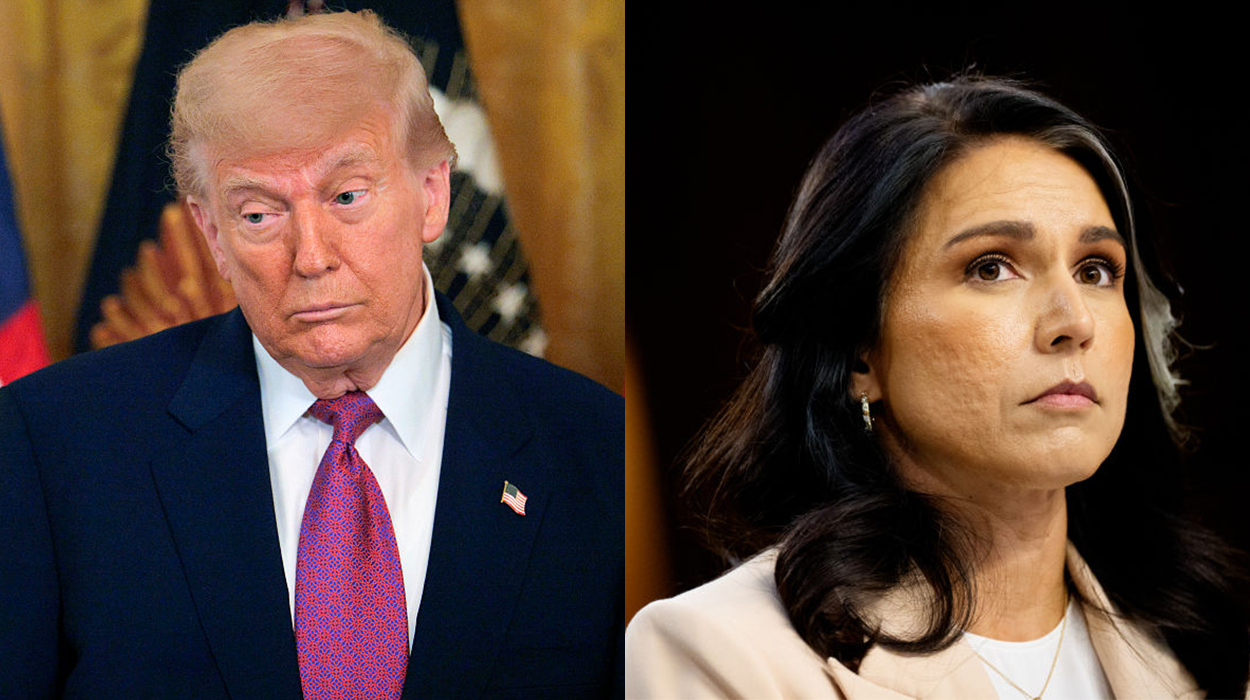- Thursday, July 17, 2025
A growing divide between President Donald Trump and Director of National Intelligence Tulsi Gabbard over Iran’s nuclear threat has come into full view, raising questions about US strategy, internal unity, and Gabbard’s future in the administration.

By: Vibhuti Pathak
The escalating Iran-Israel conflict has brought to light a widening rift at the highest levels of the US administration, exposing deep differences between President Donald Trump and his Director of National Intelligence, Tulsi Gabbard.
While both are prominent figures in the current White House, their contrasting approaches to Iran’s nuclear ambitions and US foreign policy have become increasingly public and consequential.
Trump’s Hardline Stance: “Iran Cannot Have Nuclear Weapon”
As tensions between Iran and Israel surged, President Trump abruptly left the G7 summit in Canada and returned to Washington, warning that Iran was “very close to having a nuclear weapon.”
He made a series of emphatic statements, declaring, “Iran cannot have nuclear weapon,” and urged citizens of Tehran to leave the city for their safety. Trump told reporters he wanted a “real end” to the conflict, not merely a “ceasefire,” and went as far as demanding an “unconditional surrender” from Iran.
Trump’s rhetoric closely aligned with Israeli Prime Minister Benjamin Netanyahu, who asserted that Iran could produce a nuclear weapon “in a very short time,” possibly within months. Trump’s public warnings and demands reflected a sense of urgency and a willingness to escalate pressure on Tehran, putting him in step with Israel’s most hawkish voices.
Gabbard’s Contradictory Intelligence Assessment
In stark contrast to Trump’s assertions, Tulsi Gabbard, the US Director of National Intelligence, has maintained a more measured assessment. Testifying before the House Intelligence Committee in March, Gabbard stated:
“The US intelligence community continues to assess that Iran is not building a nuclear weapon and Supreme leader Khomeini has not authorised the nuclear weapons program that he suspended in 2003. We continue to monitor closely if Tehran decides to reauthorise its nuclear weapons program.”
This position, rooted in the consensus of Western intelligence agencies, directly contradicted Trump’s public claims. When confronted with Gabbard’s remarks, Trump was dismissive: “I don’t care what she said. I think they were very close to having one.”
Gabbard attempted to downplay the apparent split, stating that Trump “was saying the same thing that I said in my annual threat assessment back in March. Unfortunately too many people in the media don’t care to actually read what I said.”
Public and Internal Fallout: “I Don’t Care What She Said”
The disagreement did not remain behind closed doors. Trump’s public dismissal of Gabbard’s intelligence assessment was widely circulated in Washington, fueling speculation about her standing within the administration. The dispute became a source of gossip on Capitol Hill, with lawmakers from both parties sharing video clips of Trump’s comments.
The rift was further inflamed when Gabbard posted a video on June 10, warning that “political elite and warmongers” were “carelessly fomenting fear and tensions between nuclear powers” and that the world was “on the brink of nuclear annihilation.” The video, seen as a veiled criticism of the administration’s approach, reportedly incensed Trump, who complained that Gabbard was speaking out of turn and even mused about eliminating the position of Director of National Intelligence altogether.
Broader Policy Differences and MAGA World Reactions
Gabbard’s skepticism of US intervention in West Asia is well known and was part of the reason Trump appointed her to the intelligence post. However, as the Iran crisis has unfolded, her anti-interventionist stance has clashed with the president’s more aggressive tone.
Trump, who campaigned on an “America First” and often isolationist agenda, has nonetheless signaled a readiness to escalate if US interests are threatened.
This divide has resonated within the broader MAGA coalition. Steve Bannon, a prominent isolationist voice, questioned why Gabbard was not invited to a key Camp David meeting on the crisis. Tucker Carlson suggested this indicated a “regime change effort” was underway, further highlighting the internal debate about the direction of US foreign policy.
White House Damage Control: “On the Same Page”
Despite the visible split, the White House has sought to downplay any internal discord. A senior official insisted, “There’s a distinction. Just because they don’t have one does not mean that they don’t want to build one.”
A spokesperson for Gabbard claimed she was “on the same page” as Trump and blamed the media for misinterpreting her remarks. White House spokesperson Steven Cheung stated the president “has full confidence in his entire exceptional national security team,” while Vice President JD Vance called Gabbard “an essential member” of Trump’s team.
Future Uncertain: Will Gabbard Remain if US Goes to War?
The public airing of differences between Trump and Gabbard raises questions about her future in the administration, especially if the US becomes directly involved in the Iran conflict. Some of Trump’s allies, including former national security adviser John Bolton, have called for her removal, arguing that her views are out of step with the president’s.
As the crisis continues, the Trump-Gabbard divide underscores the broader uncertainty and debate within the US government over how to respond to one of the most dangerous flashpoints in the Middle East